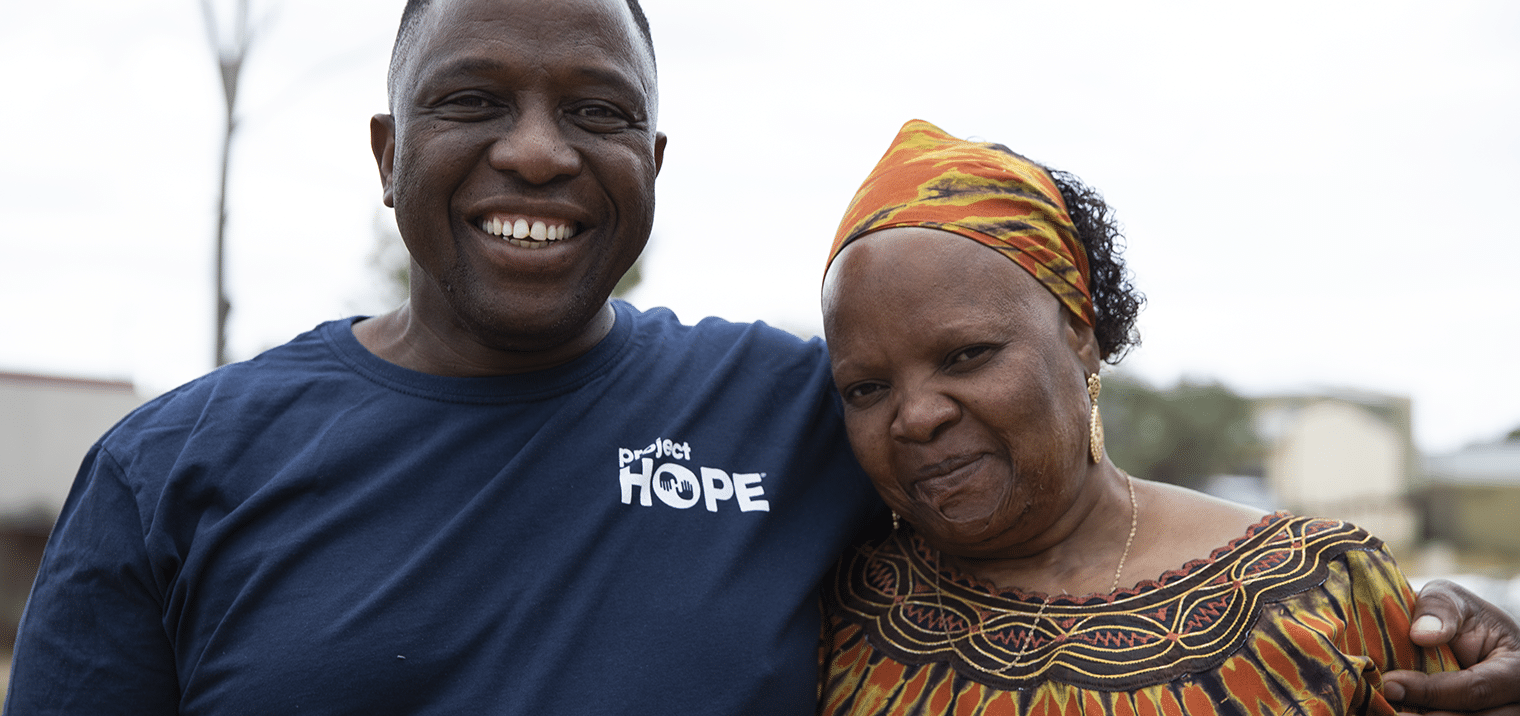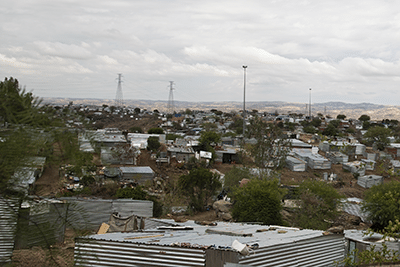
Health Workers Offer HOPE to Families in Settlements
Project HOPE works around the world to support and implement health care programs that literally change the perspective and direction of lives – for children, teenagers, mothers, families and communities.

“When I am older, I want to be successful myself – maybe a success in business,” says Delina (14), who lives in Namibia. “But I also want to help out others in the community who are not able to support themselves.”
On the outskirts of Windhoek, Namibia’s capital, stretches a sea of corrugated metal housing. A sprawling suburb of small shacks nearly stacked on top of each other, each home is practically identical in size and exterior appearance: metal, windowless, dimensionless.
There are few interior amenities. Water and sanitation are lacking: the homes share makeshift outhouses spaced sporadically throughout the otherwise barren landscape that’s divided into areas referred to as settlements.
These settlements are growing at rapid and alarming rates, as more and more families migrate from rural to urban areas in search of work and greater opportunity. The number of informal urban shacks in Namibia is projected to double over the next five years — on track to become the country’s predominant form of housing by 2023. But informal growth presents significant economic, social and environmental concerns, and the dismal conditions of these settlements are exacerbating already pressing health challenges.

A new lease on life for a mother of five
Grace lives with her five children in one of these tiny shacks in the settlement. In 2017, her health began to fail, and her life began to fall apart. “I always felt sick,” she recalls. “And I couldn’t stop coughing.”
Exhausted and unable to keep up with her children, the desperate young mother made her way to the hospital where she tested positive for HIV.
Namibia has one of the highest HIV prevalence rates in the world — its population plagued by this virus that, while incurable, is both preventable and treatable. Upon her diagnosis, Grace was immediately placed on antiretroviral treatments (ART).
As her health improved, Project HOPE’s Community Health Worker Naomi stepped into her life.
Project HOPE provides community-based prevention, care and support interventions to protect and improve the lives of those infected, affected and at-risk of HIV in Namibia.
“When I met Naomi at the hospital, she asked if she could visit me at my house,” says Grace. “After I signed the consent form, Naomi contacted the Ministry of Gender to register all the children so that they could receive social grants from the government. She helped me register them in January and by February we were receiving money.”
Namibia’s Ministry of Gender Equality and Child Welfare works to ensure gender equality and equitable socioeconomic development of women and men, as well as the well-being of children.
Grace’s tiny shack is now twice as big as it used to be thanks to the extra government assistance she receives. She decorates the inside walls with colorful fabric and keeps it neat and clean. Not only does she have the strength to care for her children, she also works outside the home.
“I am so happy to see the change in Grace’s life,” says Naomi.
In addition to ART adherence counseling, Naomi helps the family learn about good hygiene, nutrition and health education.
“Before I met Naomi, my five children and I had nothing,” says Grace.
“I want to thank Project HOPE. For so long, my children and I were suffering. Now I am very happy. I want to see my children grow up healthy and happy. I want them to use their brains and get educated. I am also hoping to use some of the government money to start a small business.”


Growing up with HIV
Teen friends Claudia, 14, and Delina, 19, also live in the settlement. Both are HIV-positive.
Delina’s mother, 47-year-old Martha, first became acquainted with Project HOPE when she was in the hospital and met Kornelia, a Project HOPE community health worker working under the Namibia Adherence and Retention Project (NARP). NARP was funded by PEPFAR (U.S. President’s Emergency Plan for AIDS Relief) through USAID to improve HIV care and treatment and is implemented by Project HOPE and Catholic AIDS Action.
Martha, like the teens, is HIV positive.
“I met Martha at the hospital and she gave me consent to meet her family and come to her home,” says Kornelia, who subsequently helped facilitate a social grant for Delina through the Ministry of Gender. Martha and Delina received other counseling services as well, including joining the project’s Village Savings and Loan (VSL) program – a program that teaches her how to save money, make profit on her savings and borrow money if necessary.
“The family is now very strong and so appreciative to Project HOPE,” says Kornelia.
Delina and Claudia’s VSL education is through a teen support group sponsored by Project HOPE that meets once a month on Saturdays. All of the teens in this group share at least one thing in common: they’re all HIV positive.

Not just surviving – but learning, growing and thriving
“Project HOPE has helped me learn how to save and spend less money. They care about people and have developed programs that will help us more in life.”
Teen clubs like Delina and Claudia’s help the youth members navigate the stigma that often accompanies an HIV diagnosis and focus on important life lessons such as financial responsibility.
“We talk about how to help people who are infected with HIV/AIDS,” says Claudia.
“You can’t discriminate against them,” adds Delina. “You have to treat them just like anyone else because there are no other differences between people who are HIV-positive and HIV-negative.”

Each teen receives a savings book to keep track of their contributions. Most teens save a portion of their government grants each month. Delina says she has saved $1,600 Namibian dollars ($108 USD). Claudia has saved $950 ($64 USD). (For point of reference, a quart of milk costs about $18 Namibian dollars. A new dress costs about $500 Namibian dollars.) Learning good savings practices gives teens like Delina and Claudia the financial knowledge and resources they need to take control of their lives.
“Project HOPE has helped people who have poverty at home,” explains Delina. “Through the savings and loan program, you can borrow money and then pay it back with interest. Project HOPE has helped me learn how to save and spend less money. They care about people and have developed programs that will help us more in life.”
Both girls agree that the multifaceted lessons learned in the club have empowered them to dream big – and to give back.
“When I am older, I want to be successful myself – maybe a success in business,” says Delina. “But I also want to help out others in the community who are not able to support themselves.”
Claudia’s dreams about studying medicine and eventually becoming a dermatologist. She’s determined not to let her circumstances block her path.
“Project HOPE has helped me to learn that my future has nothing to do with my background.”